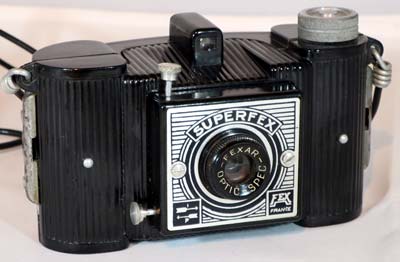Fex/Indo SuperFex
Specification

| Manufacturer | : | Fex/Indo |
|---|---|---|
| Produced | : | 1945 |
| Classification | : | Medium Format |
| Body Type | : | Solid Body |
| Construction | : | Bakelite |
| Film Type | : | 127 |
| Film Width | : | 46mm |
| ImageSize | : | 1⅝ x 2½ in |
| No. of Images | : | 8 |
| Lens Type | : | Meniscus |
| Focus Type | : | Fixed |
| Focal Length | : | 60mm |
| Focal Range | : | 3m - inf. |
| Aperture Type | : | Fixed |
| Aperture | : | f/16 |
| Shutter Type | : | leaf |
| Shutter Speeds | : | B, I*(1/100s) |
| Size (w x h x d) | : | 123 x 68 x 67 mm |
| Weight | : | 160g |
| * Measured on this camera | ||
Art Deco Credentials
![]()
![]()
![]()
![]()
Significant: Pronounced and self evident
- Produced after the main Art Deco period.
- Moulded Bakelite body.
- Design shows stepped features.
- Curvilinear shape
- Multi-line deep pattern in Bakelite.
- Multi-line geometric pattern in chrome on face plate.
Description
The camera is part of a range of cameras having similar design with regard to the Bakelite body. The heavily ribbed nature was first seen in the Fex/Indo Superior camera which came out in 1940. The ribbed design continued until 1957.
This is a 4x6.5 cm format camera, 8 images per film, using 127 film. The advance knob of the film is aluminum. The objective lens is labelled 'FEXAR - OPTIC - SPEC' and is a meniscus lens. The aperture was measured and calculated as f/16. The shutter has 2 positions: I and P (P = pose, corresponding to Bulb). The shutter release with a metal head is located on the lens plate. The shutter speed was measured at 1/100 sec although I have seen it quoted elswhere as 1/30s. Just shows the importance of measuring the speed of these old shutters if you want to use the camera.
There is no adjustment of the focus with the objective lens set on the hyperfocal distance to give a clear image between 2 or 3 meters and infinity. There is no tripod mount.
How to Use
This camera takes 127 film which is still available from select outlets - search for 'Rera Pan 100-127' which is a black & white film. For those photographers in the UK, try Nick & Trick photographic services. If you want to use a particular type of film which is not available commercially, then you can cut your own 127 film from any 120 film. See my page on 'How to cut 127 film from 120 film'.
The aperture is f/16. The measured speed on this camera was 1/100s.
The table shows how this camera will perform using ISO 100 film. It is based on the 'Sunny 16' rule. Modern film is so forgiving and will produce acceptable results even when overexposed by 2 or 3 stops or underexposed by 1 stop.
The tables assume that the sun is at least 30 degrees above the horizon - that's 10am - 5pm on a summers day in the UK.
Remember that the exposure guide in the manual may not be helpful as it is based on the use of old film with a low ISO value.
So, on a nice sunny day, it's simplicity itself. Just load film and snap away.
Using ISO 100/125 film - shutter speed 1/100s
| Weather Conditions | Shadow Detail | Aperture | Exposure |
|---|---|---|---|
 Sunny SunnySnow/Sand | Dark with sharp edges | f/16 | +1 Stop Overexposed Acceptable |
 Sunny Sunny | Distinct | f/16 | Good |
 Slight Overcast Slight Overcast | Soft around edges | f/16 | -1 Stop Underexposed Acceptable |
 Overcast Overcast | Barely visible | f/16 | -2 Stops Underexposed Not Acceptable |
 Heavy Overcast Heavy Overcast | None | f/16 | -3 Stops Underexposed Not Acceptable |
 Open Shade Open Shade/Sunset | None | f/16 | -4 Stops Underexposed Not Acceptable |